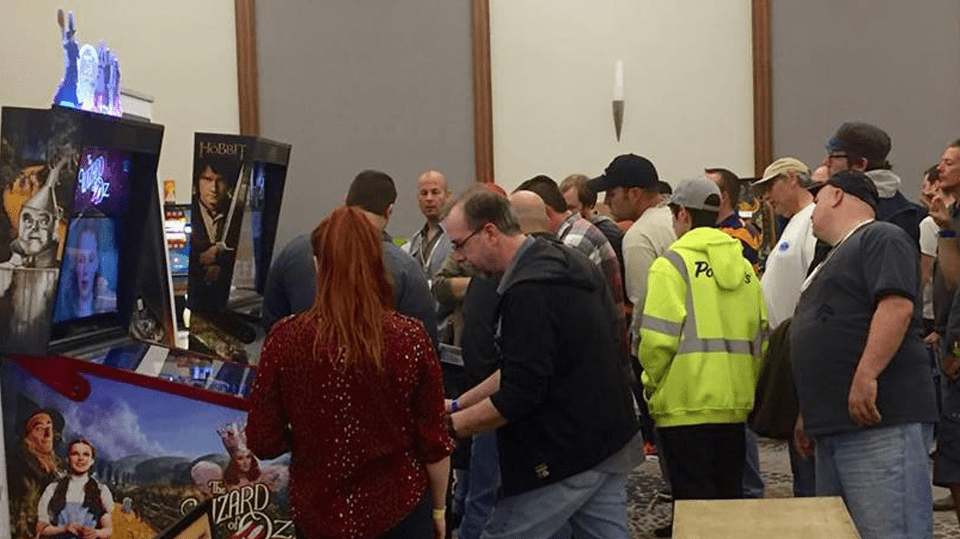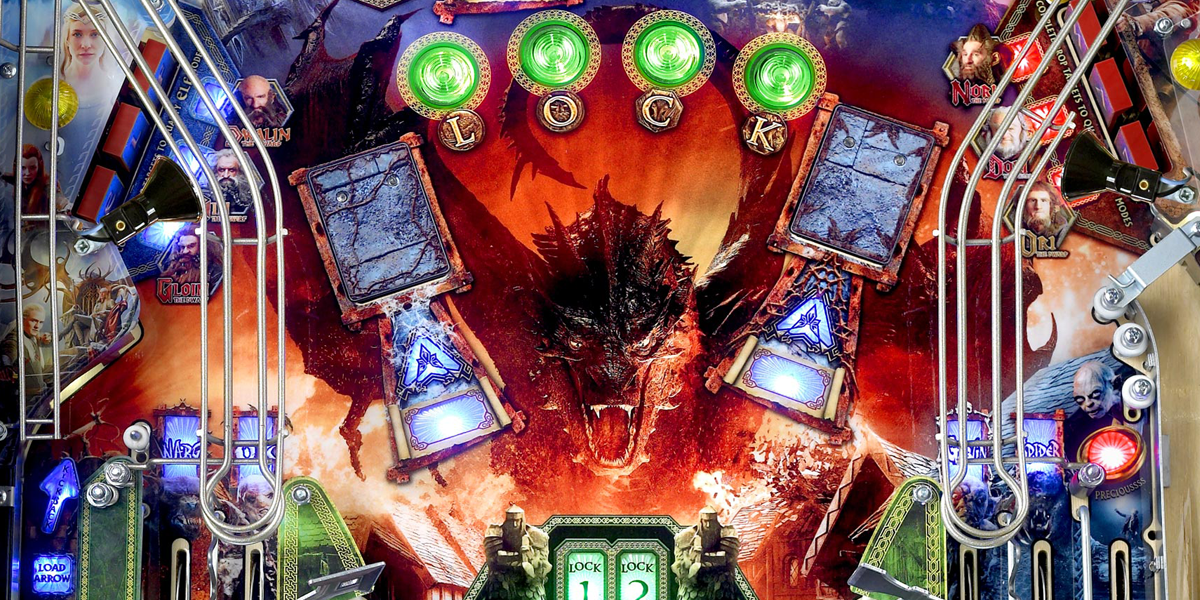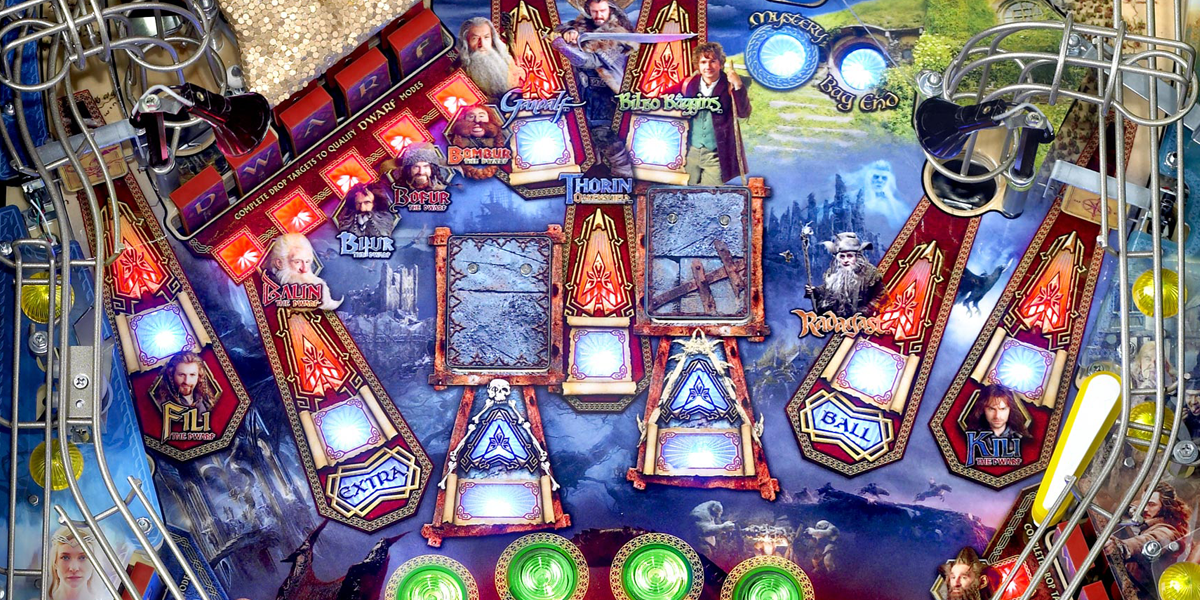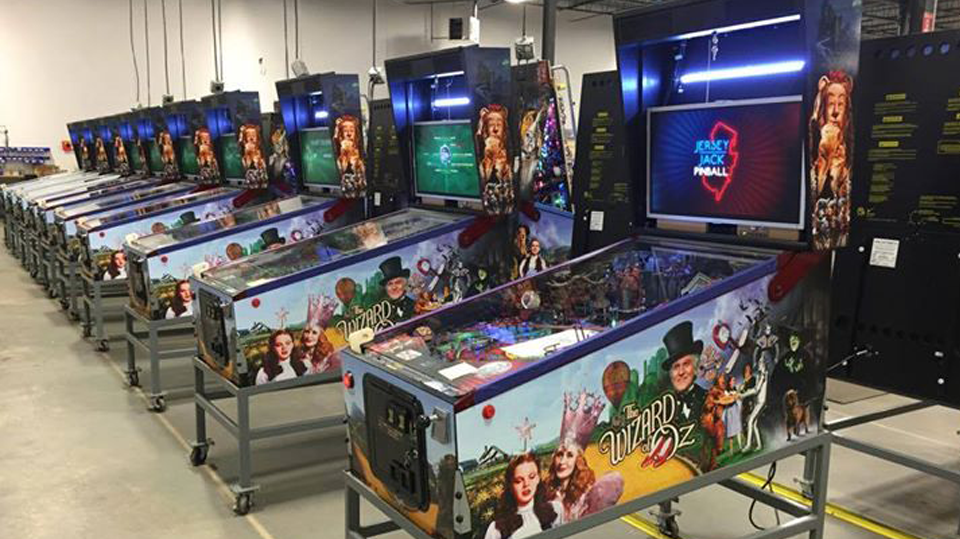The pinball industry has been riding a steady incline for the last five years, and one of the two manufacturers pushing it forward is a shop out of New Jersey.
The company is Jersey Jack Pinball, and in a discussion I had earlier with the founder “Jersey Jack” Guarnieri, we covered the ride of this unique genre of play and the ways they are innovating pinball, specifically in relation to its two games, The Wizard of Oz and The Hobbit.
Jack Guarnieri may have started Jersey Jack Pinball, and subsequently jump-started competition in the pinball industry, but he’s primarily a businessman. In the end, pinball is about great play experiences, and great play experiences are born from talented development teams. So, after my discussion with Guarnieri, I talked to two members of Jersey Jack Pinball’s development team: Jean-Paul de Win, the lead artist on The Hobbit, and the legendary pinball rules designer and coder, Keith Johnson.
Where Jean-Paul de Win is still a relatively new name to pinball, Keith Johnson is practically a household name among silver-ball enthusiasts. Johnson has handled the rules in extremely popular epic, long-form style games like The Lord of the Rings and The Simpsons Pinball Party. Both games are unique to the pinball world in that their rules are designed to be long journeys. This is the complete opposite philosophy of most other famous pinball designers, like say Steve Ritchie, who concentrate on quick and fast experiences.
AI Weekly
The must-read newsletter for AI and Big Data industry written by Khari Johnson, Kyle Wiggers, and Seth Colaner.
Included with VentureBeat Insider and VentureBeat VIP memberships.
I got a chance to talk with the team just as manufacturing and shipping of the first run of their latest game, The Hobbit, is in full swing.
GamesBeat: For those joining us that don’t know who you are, let’s do a quick introduction and mention what you did on The Hobbit.
Keith Johnson: I’m Keith Johnson, I lead software development on games. For both Wizard of Oz and The Hobbit, I came up with the overall structure and basic set of rules for the game.
Jean-Paul de Win: I’m Jean-Paul de Win, graphic artist for the LCD screen and art on the whole game [The Hobbit].
GamesBeat: Before we dive too deep into talking about designing for Jersey Jack Pinball, what other pinball machines have had the biggest influence on you? And why?
Johnson: Three games come to mind for me: Whirlwind was the game that got me started in pinball in college. It was the first game I played where I realized there were significant rules and depth to games that could keep your interest for longer periods of time.
Next was Twilight Zone, which I had viewed as the pinnacle of utilizing a licensed theme to its maximum potential when integrating game rules, objectives, toys, sounds, etc.
The third game is more about rules geekery, and possibly an unlikely choice, Jackbot.
Jackbot has a multiball with multiple levels of goals, and it remembered your progress between each play. It got harder and harder to start, but it was necessarily worth more and more because you were always further into the depth of the multiball. World Cup Soccer 94 has a similar structure, though not as fleshed out as Jackbot. It was also a game where multiple rules — not just the main multiball of the game — got harder and harder as you did them multiple times, and is a structure I’ve incorporated into every game I’ve worked on.
There’s no point if you’ve already done something in a game, it should be just as easy to do it again. But, it should get harder in an interesting way, not a boring … “wood-chopping” in pinball vernacular … way.
de Win: Twilight Zone has always been my favorite game and could be considered an inspiration. Pinball 2000 probably comes closest with the motion graphics to compare the Jersey Jack Pinball screen model.
Animation-wise, Indiana Jones: The Pinball Adventure has some dot matrix display animations that inspired me for animation on The Hobbit.
I think the video-card game Hearthstone has inspired me the most for The Hobbit user interface.
Obviously, the art on The Lord of the Rings inspired me for the play-field art, but making better use of the current assets quality.
GamesBeat: I see pinball as one of the most abstract genres of play we have. You got a game, with rules, that must be won or lost, but like video and board games, the play field … the rules … the ball, they all represent pieces of a narrative.
In Wizard of Oz, the play field represents the land of Oz and the ball is a representation of Dorothy. On a superficial level, the ball represents the physical challenges Dorothy faces in Oz. But on another level, I see the ball being a representation of her mental and emotional struggles as well. For example, certain objectives that she has to see through are more dangerous and stressful than others, represented by shots or play that is more likely to lead to a drain.
Maybe I am reading too deep into this, but I see a lot of this in other games as well. Am I onto something here, or is a cigar just a cigar?
Johnson: You’re actually on the right track. The Witch [in Wizard of Oz] is obviously your main nemesis, and so she is a somewhat dangerous target to hit, especially when you consider the two magnets in front of her that can sling the ball almost anywhere on the play field after you whack her.
The rollovers on the play field are not unlike how Dorothy meets the other three main character in the film … wandering an unknown area, then all of a sudden they just pop up.
The throne room of Oz is a big challenge to get to, and is probably the most difficult thing to shoot on the game on purpose. As I alluded to earlier, really absorbing games make maximal use of their license or theme and try to map their experience directly into pinball as much as possible.
GamesBeat: Is there a design language here that the average person may not be aware of or see? Like how film has its own visual linguistics and rules for conveying certain ideas.
Johnson: I don’t know if it’s a language per se, but obviously there are a lot of fairly standard element in pinball machines, and people expect to see most of those in a game: flippers, switches, ramps, spinners, slingshots, bumpers … it’s all about match up those elements to your source material in a way that makes sense for both pinball and the theme.
GamesBeat: I was asking Jack about this from a business perspective, but from a creative angle, pinball has three major audience members. The operator, who puts the machine out into the public and is trying to make money off of the coin drop. The collector, who spends a ridiculous amount of cash to buy limited edition games new-in-box to place in their basement. Then there is the player, who values good gameplay and design over everything else.
How does each affect your design process? Is one more desirable to design for over the other?
Johnson: For the operator, you need to design your game and its elements in such a way that the game is as problem-free as possible, and when problems do arise, that it’s as serviceable as possible. Needing to take off three ramps in order to change a slingshot rubber band is not serviceable, especially for one of the biggest failure-prone parts of a game.
For the collector, obviously everything has to look good. Good artists and a solid design that gives them a good canvas to paint on is paramount. And design not just from a ‘open area to put artwork on’ perspective, but one that’s inspiring as well with interesting shots and ball movement paths.
For the player, it’s mostly about experience. It can be challenging to keep presenting new ideas, concepts, rules, and game flow to players since a lot of things have ‘already been done’ … but this is what pinball must do to keep players engaged.
For me, personally, my strength is catering to the player. I do not have a design background from an artistic point of view, but I’ve played an awful lot of pinball of all eras, and I know what I like and don’t like, and can more or less play out ideas in my head and know how they’re going to feel in the game.
de Win: For me, in the end, I want to play a fun game with good rules and call outs. But if the art is not interesting or appealing, it might keep the player from choosing your game in a row of many others. It’s always been my goal to appeal to as many people as possible with the art and visuals I create, but I’ve learned that you can’t make everybody happy.
GamesBeat: I know this is different for every project, but for The Hobbit, did you start designing the game before or after you knew what the theme was going to be?
Johnson: Whereas it’s possible to alter a play field to another theme, it’s almost impossible to change rules and gameflow to fit another theme. But The Hobbit was known before the play field was laid out and before the rules were designed.
GamesBeat: I remember hearing the The Hobbit project was going to be designed in conjunction with the movies’ production. Although this is a product based off of a popular book that’s been in print for decades, Hollywood is Hollywood, and you can never be certain what they are going to produce in the end. Stuff gets added last-minute, entire scenes get cut, etc.
Was it a challenge putting the game together, with a licensed theme that was still organically coming together?
Johnson: Yes. At the beginning we were faced with the problem of designing the game only with the assets of the first two movies, because the licensor was not releasing anything from the final movie. Obviously, as the schedule slipped, that was less of an issue, but it provided a lot of interesting constraints.
There is very little movie [or] scene-specific wording on the play field, it is all generic ‘shoot-me’ arrows and squares. There are multiple reasons for this — having a ton of content that can’t be enumerated on a play field [anyway] — but quite simply there was no way of committing to anything in the third movie until it was seen.
GamesBeat: The Hobbit project saw a delay and missed its projected release date. People expected it to release before the final movie in the trilogy, The Hobbit: The Battle of the Five Armies.
Was there something on the design and development side that held the game up?
Johnson: The game had a poor showing at its debut, Pinball Expo 2014.
Many people expressed disappointment in the art package, and there were some geometry issues that the game would’ve benefited from that weren’t done at first, because we were trying to make production start. Redoing the game’s art opened the door to fixing things as well — opening the bumper area was the biggest one — and the resultant game is vastly improved both in terms of aesthetic value and ball flow.
de Win: Yes, we [also] did not receive any move assets before the movies were released to DVD. So I could only start implementing the latest assets after the DVD releases.
GamesBeat: I was talking with Jack about the explosion of the boutique and garage pinball developers. For the sake of being transparent, I was involved as a freelance artist with one of these groups, Skit-B, on an unannounced project. Obviously, since their Predator project imploded with licensing and legal issues, I’m not holding my breath seeing the project I was working on happening.
With that said, from my perspective, I think a lot of these developers took a blind leap into pinball development thinking it was easy. I don’t blame them, because the coding and artistic portions of designing a game are accessible. But this isn’t like designing and releasing a mobile phone game. It’s a physical and complex piece of machinery that needs to be manufactured.
What are some things you have to consider while designing, and perhaps edit down, because you’re dealing with a physical game that requires actual assembly and moving parts?
Johnson: Obviously, everything you want to put in a game has to physically fit on the play field. What most people don’t think about or realize is that there is a massive iceberg-like footprint to everything you see on top of the play field that has to fit down below.
Sometimes you lay out a game and leave an area for a toy to be designed later … you quickly find out you didn’t have anywhere near enough room left over, so your big toy suffers as a result.
I would say this happened to both the Witch in Wizard of Oz and Smaug in The Hobbit.
The interesting things that we wanted to do with the toys and their interactions with the ball were significantly compromised because of what room was left after everything else was all said and done.
GamesBeat: One of my favorite eras for pinball is the ’70s and ’80s, especially where solid state digital displays (think a display with just numbers, like a digital clock) were coming in. To me, there’s this great balance between the rules and the physical layout of the play field.
It feels like rule design and physical design are doing the lifting together. A great, fun, challenging play-field design with smart, simple, elegant rules — can be an incredibly addictive experience.
Lately, I feel that the balance has gotten out of whack. People can be easily fooled by a mediocre play-field design, which is masked by highly convoluted rules. Am I onto something here or am I just an ’80s snob?
Johnson: No, it’s an accurate statement. Lord of the Rings, which I programmed, is considered by many to be one of the best games, if not the best game ever made.
Honestly, the play field is a normal, simple fan play field. A fan play field is a game with only two flippers at the bottom of the play field, and a spray of shots laid out left to right with posts in between them. [It’s] a concept that has been around for quite a while and shows no sign of going away.
Terminator 2 was probably the first example of a real fan play field. No Fear is pretty much the ultimate fan — all shots, no bash objects or toys. Attack from Mars and Medieval Madness are both extremely popular fan games with bash toys in the middle for players to hit.
Despite the lack of creative geometry to the shots on Lord of the Rings, it did have several things going for it. Most shots could do at least two different things with the ball via diverters or locks. It had an amazing package in terms of art and sound … a great and popular license … and rules that were really fun to play and integrated extremely well with the movies.
It was a great total package with an extremely hackneyed base play-field concept.
GamesBeat: I think one of the challenges of pinball design, which video games take advantage of and do very well with because of its “level structure,” is that it’s difficult to progress a player from novice to expert aspects of the game.
You’re dealing with a public who mostly doesn’t understand the basics of the genre at all. Such as how many balls there are to play and that there’s more to the game than keeping the ball alive.
But then there is this other level, where you either start modes or you don’t. It seems like pacing a player to do very simple things first, then progress them to doing more advanced things, is difficult to design in pinball. Have you been able to tackle this problem at all? If so, how?
Johnson: You can’t force a player to either realize that there are rules to a game or to get further into a game. All you can do is make a game that is engaging, gives entertainment value to batting the ball around, and then hopefully they start to get it.
This was hopelessly difficult with dot matrix display … and earlier games, but I think with the LCD display we have a very good chance at showing people there’s a lot going on, and telling them how they can go about doing it as well.
I’ve heard stories from Wizard of Oz owners how Oz is the first game people have actually asked them about the rules, mostly because they see there is a bunch of different things to do in the display.
de Win: Because we have a high-resolution monitor now, we have more ‘room’ to show the player information about the rules during gameplay.
Although you will learn the most by watching the screen while a friend plays. You’re [as the player] too busy watching the ball, instead of the screen, but this is the same on a dot matrix display game.
During attract mode we added animations to explain to new players — newbies — how to insert coins, press start, and plunge a ball. During gameplay we show these as pop-ups onscreen to guide the new player.
GamesBeat: The back glass LCD is something I’ve been making noise about for almost a decade now. Pinball has needed this innovation for a long time. Jersey Jack Pinball finally brought it to the table with Wizard of Oz.
With that said, I imagine this has not been easy to develop for. Especially on the art side, where the canvas has suddenly gone from animating dots on a dot matrix display to full-blown, high-resolution images.
Johnson: From a programming perspective, it is obviously a challenge to drive HD graphics compared to making little buffers of stuff that’s 128 x 32 x however many shades of orange and red. It’s an even bigger design challenge to figure out how you’re going to fill that space up, with what, and how it should all work.
de Win: I’ve had no experience with creating animations for a dot matrix display, but my experience in creating HD-graphics for television is of great use here.
We’ve had to come up with a design for the interface, which is a cool creative process. I know when I started with The Hobbit, the UI had to be redesigned to match the theme. In my vision every next pinball game with a LCD will have its own screen layout to match the theme the best it can.
With dot matrix display resolutions, there’s not much variance in what you can create or to set it apart from another game. The LCD-screen has become part of the art package.
GamesBeat: Keith, you’re known for creating epic, long journey-style rules in pinball. Two of your games, Lord of the Rings and The Simpsons Pinball Party, are considered the complete opposite of short and quick designs. Each have a ton of modes and a lot of objectives to complete in order to progress through the game, to the point where I know players that have owned both of these games for years and still haven’t reached the wizard mode — the end of the game — on either machine. What’s your attraction to this rule design style?
Johnson: A couple of things. One, I am a good player, so I make games that interest me.
Two, games that have a lot to do are more attractive in the long run, whether it’s in term of earnings or in terms of longevity in someone’s basement. The last thing you want to do is plunk down $8,000 for a game for your home and have done everything the game has to offer in two weeks or less.
And with multiple layers to the rules, it’s easier to string someone along — to your above point — deeper into the game when there’s always the next level of thing to get to.
GamesBeat: Do you ever worry about player fatigue? Like, maybe there is a threshold where the rules need to be edited down? I know sometimes I’ll be playing pinball and someone will say, “Hey man! Let’s throw down on Lord of the Rings!” And in my head I am thinking, “Oh, God! There go 30 to 45 minutes!” For the record, I love Lord of the Rings, but it’s such an epic game.
Johnson: No. Obviously, you don’t want to make it so that someone has to have an hour-long game to do everything, and that was never my intention. In The Simpsons Pinball Party, lots of players will get close to the end and not finish one of the tasks, such as Alien Invasion.
They’ll then slog through all the modes again to get another shot at it and hopefully get to the final mode. That may or may not happen, and either they’ll get the big payoff or be faced with the prospect of doing it again, which is really where the fatigue sets in.
The Simpsons Pinball Party was always meant to be played this way. Depending on your skill level, maybe you get to one of the final modes each game. On better games, maybe you see a few. On your best games, you play every wizard mode one. And when the stars align, you have the game of a lifetime, you actually win all the wizard modes and get to the final mode.
The repeated slog on a single game was not something anticipated by me. A perfect playthrough — getting everything the first time, which I’ve done — can be done in 30 minutes. That feels about right to me.
GamesBeat: In the end, the overall game design has to start worrying about mechanical obstacles. Such as toys that are actually complex mechanisms that do something unique. What’s it like trying to design rules around this element?
Johnson: Generally you work hand-in-hand with the play-field designer to make sure you both are on the same page in terms of what experience you need to expose the player to, and how it’ll actually wind up being used in-game.
Lots of play field designers design their shots first, then try to force toys into the space that’s left, because the shots are more interesting to them. I wish more [play field] designers would concentrate on interesting interactivity first, and work the shots around the toys.
GamesBeat: What is the dream theme you guys wish you could work on? Forget what’s coming next for Jersey Jack Pinball, just pretend you were told you can do any theme. But seriously … you can talk about what project you’re working on next if you’d like.
Johnson: That’s a great, unanswerable question. I would love to answer it, but can’t give the competition any ideas to rip off, you know? I have lots of ideas of things I think would be amazing and cool, but, put simply, just can’t be talked about.
de WIn: I’d love to see another black and white game, like Centaur, in the form of the graphic novels and movies [like] Sin City.
VentureBeat's mission is to be a digital town square for technical decision-makers to gain knowledge about transformative enterprise technology and transact. Learn More




